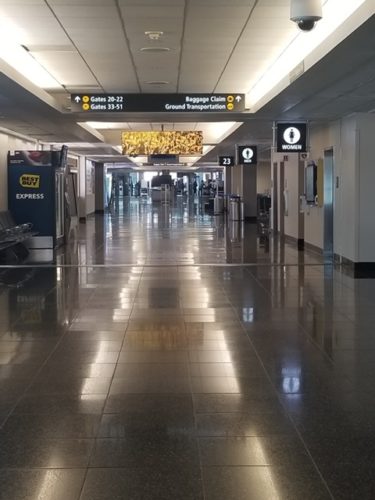
Covid-19 is disastrous for airlines and air travel, with thousands of flights already axed and more cuts being announced daily.
But the deep drop in passengers is also hammering airports.
Fewer than 100,000 passengers and crewmembers were screened at U.S. airports on April 8. That was a record low and a 95% decline from the same date a year ago, according to the Transportation Security Administration.
But airports are essential community services and must stay open.
“Especially in the time of crisis when critically needed supplies are being shipped and medical workers are being asked to travel to the hardest hit cities,” said Kevin Burke, President and CEO of airport member organization Airports Council International – North America (ACI-NA).
In a recent economic bulletin, ACI-World predicts that, globally, COVID-19 will wipe out almost half of all revenues for airports for 2020.
In the U.S., Burke says ACI-NA expects total airport operating revenue will decrease by roughly $12.3 billion for 2020, a nearly 49 percent reduction.
Some of these losses may be offset once the U.S. Transportation Department and the Federal Aviation Administration begins distributing the $10 billion airports are slated to receive from the recently signed CARES Act.
“However, we expect our losses will increase as this crisis continues,” said Burke.
How are airports coping?
Airports around the country are taking a wide variety of measures to cope and cut costs.
Efforts include closing and consolidating security checkpoints, locking yoga rooms and kids play areas, and shuttering restaurants and concessions. Many airports are even turning off escalators and moving walkways to save on electricity bills.
At Pittsburgh International Airport, which has seen a 90% reduction in the number of passengers, so many commercial flights have been canceled that the airport is using one of its four runways as a parking lot for almost 100 grounded planes.
The parking fees for those planes won’t come close to replacing revenue losses from the airport’s key income sources which, like other airports, include fees related to airline and passenger activity, said airport CEO Christina Cassotis.
“But the airport must stay open and operational as an essential part of the country’s transportation system,” she said.
“And whether we have one passenger or one plane, we must do the same work to make sure everything is in good working order, from wildlife management to cutting the grass and making sure the airfields are free of debris,” said Cassotis.
At Los Angeles International Airport, the airport’s Landside Access Modernization Program (LAMP) and terminal modernization projects are continuing as planned. But other airports are freezing work on major construction projects.
Salt Lake City International Airport (SLC) has 25 planes parked in ramp areas and de-icing pads, said airport spokeswoman Nancy Volmer. Inside the terminals, close to 50% of concessions are now closed.
Denver International Airport has closed one of its six runways and is now operating with one 24-hour checkpoint. Among a wide variety of other measures, the airport disabled the air hand dryers in restrooms to reduce the spread of germs, closed the Interfaith Chapel and is stopping valet parking in its east and west garages on April 10.
And at Florida’s Jacksonville International Airport (JAX), both concourses remain open with only three of the airport’s 13 stores and three of its 15 restaurants operating. Because the airports’ volunteer ambassador program has been suspended, the airport’s traditional and very popular Mother’s Day flower giveaway has been canceled for this year.
“There are no volunteers to hand the flowers out and really very few passengers traveling through the terminal,” said JAX spokesman Greg Willis.
Seattle-Tacoma International Airport (SEA) reports that passenger counts are down as much as 90 percent. The airport’s children’s play area is closed, both the live music and the Visitor Pass programs are suspended and a long list of bars, restaurants and shops are shuttered.
To help concession operators, some of which opened new shops, bars and restaurants in just the last month as part of the airport’s expansion and modernization programs, the Port of Seattle established a short-term emergency relief package that includes a two-month deferral of rent and fees.
Airports elsewhere are figuring out how to help tenants as well.
Rent and fee deferrals will help in the short run, But the Airport Restaurant and Retail Association, which represents more than 20 large and small airport concessionaires, is asking U.S. airports to consider offering 12 months of rent abatement.
“Our businesses are part of the nature and character of airports and were projected to do $10 billion worth of sales in 2020,” said Pat Murray, ARRA Board Chairman and Executive Vice President at SSP Group, “$2.5 billion of that would have been paid in rent and fees to airports. Now we’re looking at a sales drop of over $9.5 billion.”
If some sort of relief isn’t offered, he said, “our sector may cease to exist.”
Thanks for visiting Stuck at the Airport. Subscribe to get daily travel tidbits. And follow me on Twitter at @hbaskas and Instagram.